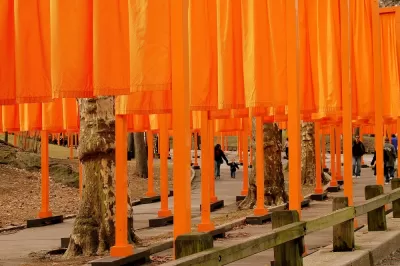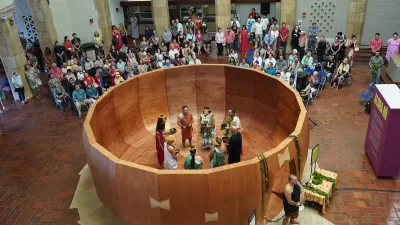Christo's site-specific artworks were known for their whimsy and playfulness. But the real beauty of his art lay in his ability to navigate local bureaucracies—and reveal how ridiculous they can be.

"Christo's pieces are no mere "public art," like the typical sculpture deposited arbitrarily in the plaza of an office building or the median of a boulevard (often paid for as penance by a developer). And they aren't just place-based. They are based in, and rely upon, specific places that are unique and irreplaceable. And they don't just occupy those places. They borrow those places. They use and transform them, and then they give them back."
"These are questions most artists (like most people) deliberately avoid. Art is the opposite of bureaucracy. Artists retreat to their studios to avoid tedious questions such as these. But Christo embraced the tedium. He met it head-on, and he figured out how to triumph over it (and even Triomphe over it). He did so because, in addition to clearly loving the sport of it, he knew that the result would be worthwhile."
FULL STORY: What Christo Taught Us About Land Use Policy

Alabama: Trump Terminates Settlements for Black Communities Harmed By Raw Sewage
Trump deemed the landmark civil rights agreement “illegal DEI and environmental justice policy.”

Study: Maui’s Plan to Convert Vacation Rentals to Long-Term Housing Could Cause Nearly $1 Billion Economic Loss
The plan would reduce visitor accommodation by 25% resulting in 1,900 jobs lost.

Why Should We Subsidize Public Transportation?
Many public transit agencies face financial stress due to rising costs, declining fare revenue, and declining subsidies. Transit advocates must provide a strong business case for increasing public transit funding.

Wind Energy on the Rise Despite Federal Policy Reversal
The Trump administration is revoking federal support for renewable energy, but demand for new projects continues unabated.

Passengers Flock to Caltrain After Electrification
The new electric trains are running faster and more reliably, leading to strong ridership growth on the Bay Area rail system.

Texas Churches Rally Behind ‘Yes in God’s Back Yard’ Legislation
Religious leaders want the state to reduce zoning regulations to streamline leasing church-owned land to housing developers.
Urban Design for Planners 1: Software Tools
This six-course series explores essential urban design concepts using open source software and equips planners with the tools they need to participate fully in the urban design process.
Planning for Universal Design
Learn the tools for implementing Universal Design in planning regulations.
Caltrans
Smith Gee Studio
Institute for Housing and Urban Development Studies (IHS)
City of Grandview
Harvard GSD Executive Education
Toledo-Lucas County Plan Commissions
Salt Lake City
NYU Wagner Graduate School of Public Service





























